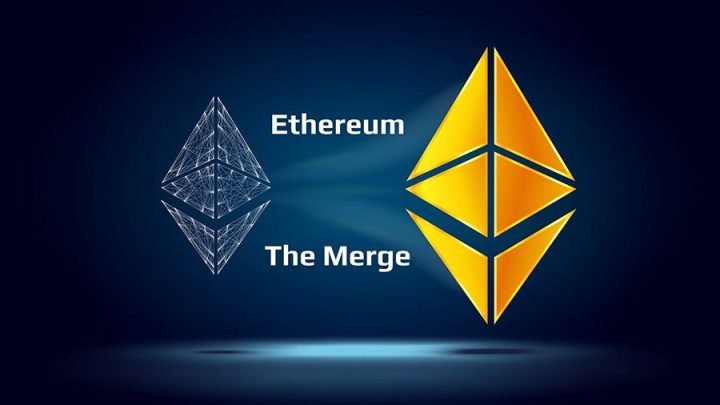
Ethereum stands as a pioneering force in the realm of blockchain technology, recognized for its pivotal role in fostering the growth of decentralized finance (DeFi) and driving innovations in smart contracts. Recently, the Ethereum community has been immersed in discussions surrounding a momentous development – the Ethereum Merger. This proposed transition marks a significant shift for the platform, aiming to enhance its scalability, security, and sustainability. The merger entails moving away from the current proof-of-work (PoW) consensus mechanism to adopt a proof-of-stake (PoS) model. This transition holds the promise of reducing energy consumption while improving network efficiency. As Ethereum evolves into its next phase, investors, developers, and enthusiasts alike are closely monitoring the implications of this transition and its potential to shape the future of blockchain technology and decentralized applications.
Exploring the Merger Concept
The Ethereum Merger signifies a planned migration from the prevailing proof-of-work (PoW) consensus mechanism to proof-of-stake (PoS), with the overarching goal of bolstering the scalability, security, and sustainability of the Ethereum network. Unlike PoW, where miners compete to solve complex mathematical puzzles to validate transactions and create new blocks, PoS selects validators to forge new blocks based on the amount of cryptocurrency they hold and are willing to “stake” as collateral. This transition promises several advantages, including reduced energy consumption and increased transaction throughput. By decentralizing the process of block creation and reducing the reliance on energy-intensive mining operations, Ethereum aims to address long-standing scalability concerns and pave the way for a more inclusive and eco-friendly blockchain ecosystem. As discussions surrounding the Ethereum Merger continue to gain traction, stakeholders are closely monitoring its potential impact on network dynamics, user experience, and broader implications for the blockchain industry.
The Problem with Proof-of-Work
Proof-of-work, though effective, has encountered criticism primarily due to its energy-intensive mining process and inherent scalability limitations. The energy consumption associated with PoW has raised environmental concerns and contributed to the perception of inefficiency within the blockchain space. Ethereum’s pivot to proof-of-stake (PoS) represents a concerted effort to tackle these issues head-on. PoS operates on a different principle, relying on validators who are selected to forge new blocks based on the amount of cryptocurrency they hold and are willing to “stake” as collateral. This approach significantly reduces energy consumption compared to PoW, making it a more environmentally sustainable alternative. Additionally, PoS offers improved scalability, enabling the Ethereum network to process a higher volume of transactions efficiently. By transitioning to PoS, Ethereum aims to enhance its ecological footprint while also addressing scalability concerns, positioning itself for long-term viability and growth in the rapidly evolving blockchain landscape.
Understanding Proof-of-Stake
Proof-of-stake (PoS) diverges from proof-of-work (PoW) by employing a distinct mechanism wherein validators are selected to forge new blocks based on the cryptocurrency they possess and are willing to “stake” as collateral. Unlike PoW, which necessitates energy-intensive mining processes to validate transactions and create new blocks, PoS operates more efficiently by leveraging validators’ stakes as a determining factor for block creation. This paradigm shift significantly reduces energy consumption, mitigating the environmental impact associated with traditional mining methods. Moreover, PoS holds promise for scalability enhancements, as it streamlines the block creation process and facilitates faster transaction throughput. By transitioning to PoS, Ethereum aims to foster a more sustainable blockchain ecosystem while concurrently addressing scalability challenges. This transition represents a pivotal step towards improving the efficiency and effectiveness of blockchain networks, paving the way for broader adoption and innovative applications in the decentralized finance (DeFi) landscape.
Ethereum 2.0: The Beacon Chain
The shift to proof-of-stake (PoS) is integral to Ethereum 2.0, a comprehensive upgrade that introduces the Beacon Chain – a distinct PoS blockchain designed to orchestrate the PoS consensus and shard chains. Unlike the current single-chain architecture, Ethereum 2.0 employs sharding, dividing the network into smaller, more manageable partitions to enhance scalability and efficiency. The Beacon Chain serves as the backbone of this new architecture, coordinating validators, managing the PoS consensus, and facilitating cross-shard communication. By segregating responsibilities across multiple chains and introducing PoS, Ethereum 2.0 lays the groundwork for a more scalable and secure network. PoS not only reduces energy consumption but also promotes decentralization by enabling more participants to contribute to network security through staking. This upgrade represents a significant step forward for Ethereum, positioning it to accommodate growing demand and unlock new use cases while maintaining its commitment to decentralization and security.
Impact on Ethereum’s Supply Dynamics
A critical aspect of the merger is its potential to reshape Ethereum’s supply dynamics. As Ethereum transitions to proof-of-stake (PoS), the issuance of new Ether (ETH) is expected to decline. This shift could have profound implications for Ethereum’s supply-demand dynamics and price trajectory. With PoS, validators are rewarded with transaction fees and newly minted ETH for validating transactions and securing the network. However, unlike proof-of-work (PoW), where miners continuously generate new coins, PoS issuance is typically lower and more predictable. As a result, the reduction in new ETH issuance may lead to a decrease in the overall supply growth rate. This change could potentially impact Ethereum’s price dynamics, as a decrease in new supply may drive scarcity and contribute to upward price pressure, assuming demand remains constant or increases. Investors are closely monitoring these supply dynamics as Ethereum undergoes its transition to PoS, anticipating potential shifts in market dynamics and investment strategies.
Implications for Ethereum Miners
The Ethereum Merger signifies a seismic shift for miners who presently secure the network via proof-of-work (PoW) mining. With Ethereum transitioning to proof-of-stake (PoS), the traditional mining process will become redundant, compelling miners to reassess their operations and potentially pivot to other cryptocurrencies. PoS eliminates the need for energy-intensive computational tasks, instead relying on validators who stake their Ether to validate transactions and secure the network. Consequently, miners heavily invested in hardware and infrastructure tailored for PoW may face significant challenges in adapting to the new consensus mechanism. While some miners may choose to repurpose their equipment for alternative mining ventures, others may explore opportunities in staking or shift their focus to mining other cryptocurrencies that continue to utilize PoW. The Ethereum Merger underscores the dynamic nature of the cryptocurrency ecosystem, highlighting the importance of flexibility and innovation in navigating technological transitions and evolving market trends.
Staking Opportunities for Investors
As Ethereum transitions to proof-of-stake (PoS), investors are presented with the opportunity to engage in staking by pledging their Ether holdings as collateral to validate transactions and earn rewards. Staking offers investors a passive income stream while simultaneously bolstering the security and decentralization of the network. By participating in staking, investors contribute to the validation and block creation process, thereby enhancing the overall robustness of the Ethereum ecosystem. Additionally, stakes are incentivized with rewards, typically in the form of additional Ether, for their contributions to network security. This passive income stream provides investors with an alternative avenue for generating returns on their cryptocurrency holdings, beyond traditional trading or investment strategies. Moreover, by actively participating in staking, investors play a vital role in promoting the decentralization of the Ethereum network, further aligning with the core principles of blockchain technology. Staking represents a compelling opportunity for investors to both earn rewards and contribute to the resilience of the Ethereum network.
Potential Network Upgrades and Challenges
Despite the potential benefits in scalability and sustainability, the Ethereum Merger is not without its challenges and risks. Technical hurdles may arise during the implementation of network upgrades, leading to delays or unforeseen issues. Such disruptions could potentially impact the user experience and erode investor confidence in the project. Delays in upgrades may hinder Ethereum’s ability to address pressing scalability concerns, potentially limiting its competitiveness in the rapidly evolving blockchain landscape. Moreover, unexpected technical issues could undermine the perceived reliability and robustness of the Ethereum network, raising doubts among users and investors alike. To mitigate these risks, Ethereum developers must prioritize thorough testing and meticulous planning to minimize the likelihood of disruptions. Additionally, transparent communication regarding the progress and challenges of the merger is essential to maintaining stakeholder trust and confidence in Ethereum’s long-term vision and viability.
Market Reaction and Price Volatility
The announcement and execution of the Ethereum Merger are poised to impact market sentiment and induce price volatility. Investors should anticipate fluctuations in Ethereum’s price as the network navigates this substantial transition. This period of uncertainty may lead to heightened market activity and increased price swings as stakeholders adjust their positions and strategies in response to evolving developments. As such, investors are advised to exercise caution and remain vigilant, ensuring their investment decisions align with their risk tolerance and long-term objectives amidst the shifting landscape of the Ethereum ecosystem.
Long-Term Investment Considerations
Despite short-term volatility, the Ethereum Merger reaffirms the project’s dedication to innovation and sustainability. Long-term investors are encouraged to prioritize Ethereum’s fundamentals, encompassing its robust developer community, widespread network adoption, and ongoing technological advancements. By focusing on these foundational aspects, investors can maintain perspective amidst market fluctuations and remain confident in Ethereum’s potential for long-term growth and value creation. Embracing the project’s commitment to innovation and sustainability, investors can position themselves to capitalize on the transformative potential of blockchain technology and decentralized applications within the evolving digital landscape.
Diversification Strategies in the Crypto Market
In light of the dynamic nature of blockchain technology, investors are advised to diversify their crypto portfolios beyond Ethereum. Exploring promising projects with distinct value propositions can help mitigate risks and seize opportunities in the broader crypto market. Diversification allows investors to spread their exposure across multiple assets, reducing the impact of adverse events on any single investment. By embracing a diverse portfolio strategy, investors can position themselves to benefit from the potential growth and innovation across various blockchain projects, while also safeguarding against volatility and uncertainties inherent in the crypto market.
Regulatory and Legal Considerations
With cryptocurrencies increasingly in the spotlight, regulatory scrutiny is unavoidable. Investors must stay abreast of regulatory shifts and compliance obligations to navigate potential legal hurdles and safeguard their investments. Regulatory frameworks vary across jurisdictions, impacting the legality and operation of crypto assets. By staying informed and compliant, investors can mitigate regulatory risks and ensure their investments align with legal parameters. Additionally, adherence to regulations promotes market integrity and investor protection, fostering a sustainable and secure environment for cryptocurrency adoption and growth. In the face of evolving regulatory landscapes, proactive engagement and compliance are essential for navigating the complexities of the crypto market.
Conclusion
The Ethereum Merger marks a pivotal moment in the Ethereum network’s evolution, presenting both challenges and opportunities. Despite uncertainties, it heralds a future characterized by enhanced scalability, sustainability, and decentralization. Investors who grasp the implications and embrace these changes position themselves to reap rewards from Ethereum’s sustained growth and ongoing innovation. By acknowledging the transformative potential of the merger and adapting investment strategies accordingly, stakeholders can capitalize on Ethereum’s trajectory toward a more robust and inclusive ecosystem. As Ethereum advances, proactive engagement and forward-thinking investment approaches will be key to unlocking its full potential in the ever-changing landscape of blockchain technology.






